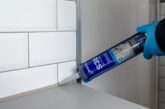
 Nick Bratt, National Sales Manager at Saint-Gobain Abrasives, discusses the adhesives and sealants that pave the way for alternative building methods.
Nick Bratt, National Sales Manager at Saint-Gobain Abrasives, discusses the adhesives and sealants that pave the way for alternative building methods.
Adhesives and sealants have come a long way in recent years; what was once a simple toolbox addition now offers tradespeople superior performance on-site and can act as a great alternative to traditional mechanical fasteners. Construction adhesives are now highly sought by trade professionals due to their diverse qualities and the range of projects they cater for. But with so many types, brands, and formulas on the market, it’s hard to know which product is best for which job.
Hybrid technology
One product type which has been growing in popularity is hybrid adhesives and sealants, as they offer a cost-effective solution that combines many benefits from different types of adhesives and sealants all in one product, resulting in improved performance and longer-lasting results.
In addition, some MS hybrid adhesives, just like those in the OneBond range, offer unique properties such as high UV and humidity resistance to withstand high temperatures, the ability to be painted once cured and are suitable for underwater applications.
Adhesive bonding is widely used in modern construction due to its ability to permanently join dissimilar materials such as metals and plastics substrates. This type of bonding also permits higher construction rates and allows for more freedom in the design process. It’s perfect for working with materials that cannot be welded or secured with traditional fasteners.
![]()
Cyanoacrylate or “instant adhesives” are designed to quickly bond small plastic or metal parts. While long open-time epoxy-based adhesives are ideal for assembling and repairing large applications or complex shapes where maximum durability is required, such as sealing exterior pipe joints, sealing cracked concrete, filling oversized bolt holes, fixing anchors and repairing pipes and tanks.
Adhesives and sealants are perfect for maintenance and repair operations on structural components and can meet almost any process requirement in terms of environmental resistance, heat resistance and curing time, amongst many other examples. These substances can even help the end product to have a lighter mass than its metallic fastener counterparts.
In bathroom and kitchen settings, it is vital that all products, including sealants, are both sanitary and waterproof – two benefits found across the OneBond range. At OneBond, we have worked to ensure our silicone sealants feature resistance against sunlight, temperature variation, humidity, shrinkage and even ozone.
For day-to-day applications, polyurethane products have become the go-to product for tradespersons. OneBond’s polyurethane products can fill expansion joints and seal joints between concrete structures, brickwork, and masonry. They can also seal gutters, secure roof tiles, and assemble and seal door/window framing components.
Sustainability
As the industry works to become more sustainable, adhesives and sealants can be a fantastic tool when considering the environmental impact of a project. When creating OneBond, for example, we focused on making our products as environmentally friendly as possible, prioritising low emissions and eco-friendly packaging options.
Tradespeople should check their adhesive products for Volatile Organic Compounds (VOCs), which can be harmful to human health. Looking for the EMICODE label on product packaging will also mean adhesives and sealants comply with the most stringent emission limits. At OneBond, we have made low-emissions a priority for our products, with most of our products having an A+ EMICODE label.
![]()
User safety
There are a few key factors that contractors should be taking into consideration when dealing with adhesives and sealants – toxicity, flammability and irritants.
Contractors are often advised to use adhesives and sealants in well-ventilated areas to avoid inhaling the fumes and vapours due to the potentially harmful formulas, or to strictly avoid contact with the skin or eyes.
Manufacturers work to ensure that these raw materials are compounded in a safe environment. However, once formulated, it’s the user who has the responsibility to handle and dispose of adhesive and sealant products safely.
To ensure you are working with the safest and most user-friendly adhesives, look out for low toxicity, low VOC and low odour formulas – particularly for users prone to sensitivities.
Our OneBond range addresses all the core needs of tradespeople working in the construction sector. We have focused on keeping the range concise and easy to understand with clear and informative packaging.
OneBond ensures there is an adhesive or sealant for every kind of job, no matter how big or small, and offers more economical options in its acrylic sealant range. Prioritising user safety with low toxicity, low VOC and low odour formulas, these sealants boast high-end, architectural performance at competitive prices.
To learn more about the OneBond range click here.
![]()







